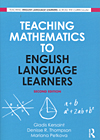- About MAA
- Membership
- MAA Publications
- Periodicals
- Blogs
- MAA Book Series
- MAA Press (an imprint of the AMS)
- MAA Notes
- MAA Reviews
- Mathematical Communication
- Information for Libraries
- Author Resources
- Advertise with MAA
- Meetings
- Competitions
- Programs
- Communities
- MAA Sections
- SIGMAA
- MAA Connect
- Students
- MAA Awards
- Awards Booklets
- Writing Awards
- Teaching Awards
- Service Awards
- Research Awards
- Lecture Awards
- Putnam Competition Individual and Team Winners
- D. E. Shaw Group AMC 8 Awards & Certificates
- Maryam Mirzakhani AMC 10 A Awards & Certificates
- Two Sigma AMC 10 B Awards & Certificates
- Jane Street AMC 12 A Awards & Certificates
- Akamai AMC 12 B Awards & Certificates
- High School Teachers
- News
You are here
Teaching Mathematics to English Language Learners

Publisher:
Routledge
Publication Date:
2013
Number of Pages:
201
Format:
Paperback
Edition:
2
Series:
Teaching English Learners Across the Curriculum
Price:
42.95
ISBN:
9780415629775
Category:
Monograph
There is no review yet. Please check back later.
Part 1 – Your English Language Learner 1.1 Orientation 1.2 – The Process of English Language Learning and What to Expect 1.3 -- Different Types of ESOL Programs 1.4 – Teaching for English Language 1.5 – Not All ELLs are the Same1.6 – Questions for Discussion and Reflection Part 2 – Influences on the Mathematics Attainment of English Language Learners 2.1 – Overview: Influences on the Mathematical Attainment of English Language Learners 2.2 – Providing an Equitable Mathematics Education to English Language Learners: Mathematics Education 2.3 – The Nature of Mathematics 2.4 – Mathematics Teaching and Learning 2.5 – Cultural Influences on Mathematics Learning and Engagement 2.6 – Assessment Results, Practices, and Procedures 2.7 – Questions for Discussion and Reflection Part 3 – Best Practices to Support English Language Learners in the Mathematics Classroom 3.1 – Overview: Classroom Environments that Support English Language Learners 3.2 – Orchestrating Classroom Discourse to Support Mathematics Concepts and Language Development 3.3 – Strategies to Help English Language Learners Understand Mathematics Language 3.4 – Emphasizing and Supporting Problem 3.5 – Assessing English Language Learners in Equitable Ways 3.6 – Teaching Mathematics in Ways that are Culturally 3.7 – Questions for Discussion and Reflection Part 4 Collaborations to Support ELLs 4.1 Overview: Collaborations to Support ELLs 4.2 – Strategies for Mathematics Teachers Who are Themselves ELLs 4.3 Mathematics Teachers Collaborating with English as Second Language Learners 4.4 ELL Home—School Communication 4.5 Questions for Discussion and Reflection
- Log in to post comments




